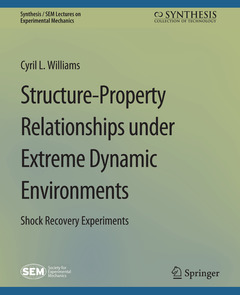Structure-Property Relationships under Extreme Dynamic Environments Shock Recovery Experiments Synthesis / SEM Lectures on Experimental Mechanics Series
Langue : Anglais
Auteur : Williams Cyril L.

The inelastic response and residual mechanical properties acquired from most shock compressed solids are quite different from those acquired from quasi-static or moderate strain rates. For instance, the residual hardness of many shock compressed metals has been found to be considerably lower than those loaded under quasi-static conditions to the same maximum stress. However, the residual hardness of shock compressed metals is much higher than those loaded quasi-statically to the same total strain. These observations suggest that the deformation mechanisms active during inelastic deformation under shock compression and quasi-static or moderate rates may be quite different. Therefore, the primary objective of this short book is to offer the reader a concise introduction on the Structure-Property Relationships concerning shock compressed metals and metallic alloys via shock recovery experiments.The first phase of the book, chapters 1 through 3 provides a brief historical perspective on the structure-property relationships as it pertains to shock compression science, then plastic deformation in shock compressed metals and metallic alloys is described in terms of deformation slip, deformation twinning, and their consequences to spall failure. Existing knowledge gaps and limitations on shock recovery experiments are also discussed. The fundamentals of shock wave propagation in condensed media are presented through the formation and stability of shock waves, then how they are treated using the Rankine-Hugoniot jump relations derived from the conservation of mass, momentum, and energy. The equation of states which govern the thermodynamic transition of a material from the unshock state to the shock state is briefly described and the elastic-plastic behavior of shock compressed solids is presented at the back end of the first phase of this book. The second phase of the book describes the geometry and design of shock recovery experiments using explosives, gas and powder guns. Then results derived from the residual mechanical properties, microstructure changes, and spall failure mechanisms in shock compressed metals and metallic alloys with FCC, BCC, and HCP crystal lattice structures are presented. Also, results on the residual microstructure of explosively compacted powders and powder mixtures are presented. Lastly, the book closes with the new frontiers in shock recovery experiments based on novel materials, novel microscopes, novel mechanical processing techniques, and novel time-resolved in-situ XRD shock experiments.
Preface.- Introduction.- Shock Wave Propagation in Condensed Media.- Shock Recovery Experiments.- Deformation Mechanisms and Spall Failure.- The New Frontier in Shock Recovery Experiments.- References.- Author's Biography.
Dr. Cyril L. Williams, P.E. is currently a Senior Research Engineer at the U.S. Army Research Laboratory. He is a Fellow of the American Society of Mechanical Engineers (ASME), Fellow of the African Scientific Institute (ASI), U.S. Army Research Laboratory Distinguish Scholar, and Federal Engineer of the Year 2015 (Department of the Army). He earned his B.Sc. and M.Sc. in Mechanical Engineering (Fatigue and Fracture) from the University of Maryland Baltimore County, then M.Sc. and Ph.D. in Mechanical Engineering (Shock Compression Science) from The Johns Hopkins University. He is currently the Army's Subject Matter Expert (SME) on the structure-property relationships in condensed matter under extreme dynamic environments. He started his career as a design engineer with the American Bottlers Equipment Company (AMBEC) in 1992 and later joined E. I. DuPont de Nemours & Co. in 2000 as a Consultant in Reliability and Mechanical Testing (Engineering Mechanics Group). Dr. Williams is a licensed Professional Engineer in Delaware (#13160) and Maryland (#44307). He is currently the executive head of ASME Government Relations (Delaware Section), member of the American Physical Society (APS)-Shock Compression of Condensed Matter (SCCM) Executive Committee and an active member of several research societies including the Sigma Xi, Society of Experimental Mechanics (SEM), The Minerals, Metals and Materials Society (TMS), and Tau Beta Pi Engineering Honor Society (TBP). He has given numerous invited talks nationally and internationally including University of Cambridge (Cavendish Laboratory), California Institute of Technology, Imperial College London (Institute of Shock Physics), and the Massachusetts Institute of Technology.
Date de parution : 01-2019
Ouvrage de 143 p.
19.1x23.5 cm
Disponible chez l'éditeur (délai d'approvisionnement : 15 jours).
Prix indicatif 52,74 €
Ajouter au panierThème de Structure-Property Relationships under Extreme Dynamic... :
© 2024 LAVOISIER S.A.S.



